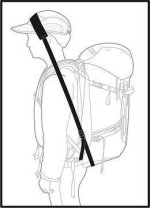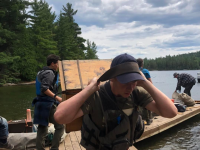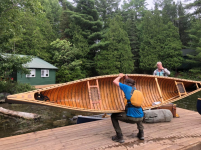Admittedly resurrecting an old thread here, I've been thinking of using a tump for portaging my wood/canvas canoes. I live very close to a significant Amish community here in southeast PA, and because of the horse drawn buggies and farm equipment, there are a number of harness shops which make leather harness. I'll bet I can get a fine tump made locally to my specifications. With that in mind, I just came across this article about tying and sizing the tump knot for carrying a wanigan, and thought it might be of interest here.
-
Happy Publication of Dickens' "A Christmas Carol" (1843)! 😠👻🩼🎄
You are using an out of date browser. It may not display this or other websites correctly.
You should upgrade or use an alternative browser.
You should upgrade or use an alternative browser.
Tumplines
- Thread starter Mnoutdoorfunguy
- Start date
For those interested in adding a tumpline, Duluth and others sell them at reasonable prices. I think Duluth get $15 for theirs. And I have a pattern for sewing one out of webbing and canvas. If anyone is interested I' post the cut piece sizes and sewing instructions.
Lance
Lance
Last edited:
Please do!For those interested in adding a tumpline, Duluth and others sell them at reasonable prices. I think Duluth get $15 for theirs. And I have a pattern for sewing one out of webbing and canvas. If anyone is interested I' post the cut piece sizes and sewing instructions.
Lance
FYI - if you're interested and in the area we've got a guy who's scheduled to be at Canoe Day on April 16 who will be talking and demonstrating the use of wannigans and tumplines.
See this entry in the Events section: https://www.canoetripping.net/threads/events-schedule-at-white-rose-canoe.127139/
See this entry in the Events section: https://www.canoetripping.net/threads/events-schedule-at-white-rose-canoe.127139/
Last edited:
Keep in mind that societies that use tump lines or carry loads on their heads start at a very early age. They develop good technique and strong paraspinal muscles when they are young and progressively build up. In some of these societies a person's livelihood may depend on carrying loads on their heads, and they have no workman's compensation benefits. These folks are very different than the typical American "weekend warrior" who decides to try bearing axial loads on the cervical spine during middle age, or later.
Cervical spinal disease severe enough to cause radiculopathy is pretty common in the US. Most people who have cervical disease bad enough to cause radiculopathy are going to be aware of the problem but MRI surveys have also shown a very significant incidence of herniated nucleus pulposus (HNP) and cervical degenerative disc disease (DDD) in individuals who are completely asymptomatic at the time of the MRI. The incidence of HNP in asymptomatic individuals less than 40 years of age is around 5%. The incidence of cervical DDD in asymptomatic individuals around 25% in those less than 40 but 60% in those older than 40.
Placing an axial load on the cervical spine is not a great idea for anyone with significant cervical spinal disease, especially if symptomatic.
 emedicine.medscape.com
emedicine.medscape.com
Cervical spinal disease severe enough to cause radiculopathy is pretty common in the US. Most people who have cervical disease bad enough to cause radiculopathy are going to be aware of the problem but MRI surveys have also shown a very significant incidence of herniated nucleus pulposus (HNP) and cervical degenerative disc disease (DDD) in individuals who are completely asymptomatic at the time of the MRI. The incidence of HNP in asymptomatic individuals less than 40 years of age is around 5%. The incidence of cervical DDD in asymptomatic individuals around 25% in those less than 40 but 60% in those older than 40.
Placing an axial load on the cervical spine is not a great idea for anyone with significant cervical spinal disease, especially if symptomatic.
Cervical Disc Disease: Practice Essentials, Pathophysiology, Epidemiology
Cervical disc disorders encountered in physiatric practice include herniated nucleus pulposus (HNP), degenerative disc disease (DDD), and internal disc disruption (IDD). HNP (seen in the image below) is defined as localized displacement of nucleus, cartilage, fragmented apophyseal bone, or...
Last edited:
This showed up on Youtube this month
Great video! I tump my canoes and gear. I have come to really appreciate them on longer portages.
Bob
Bob
This article discusses the benefits and risks of tumpline carrying from historical, cultural, statistical and medical perspectives:

 www.theatlantic.com
www.theatlantic.com
Yvon Chouinard, the founder of the Patagonia Company, studied how Nepalese porters tump carry heavy loads all their lives. Note how he recommends attaching the tumpline to the bottom of the load for proper spine angle pressure:

Head carrying for heavy loads or just posture improvement has been practiced worldwide for centuries:




Even in 1933, your doctor probably wouldn't have recommended this as canoe portage practice:

Why It’s Better to Carry Weight on Your Head
People have done it for centuries. Maybe everyone still should.
Yvon Chouinard, the founder of the Patagonia Company, studied how Nepalese porters tump carry heavy loads all their lives. Note how he recommends attaching the tumpline to the bottom of the load for proper spine angle pressure:

Head carrying for heavy loads or just posture improvement has been practiced worldwide for centuries:




Even in 1933, your doctor probably wouldn't have recommended this as canoe portage practice:
Similar threads
- Replies
- 14
- Views
- 397
- Replies
- 3
- Views
- 414




